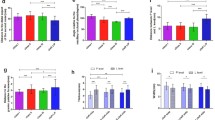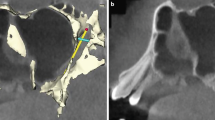Abstract
Purpose
To determine the rate of complications and occurrence of pterygoid plate fractures comparing two techniques of Le Fort I osteotomy i.e., Classic Pterygomaxillary Dysjunction technique and Trimble technique and to know whether the dimensions of pterygomaxillary junction [determined preoperatively by computed tomography (CT) scan] have any influence on pterygomaxillary separation achieved during surgery.
Materials and methods
The study group consisted of eight South Indian patients with maxillary excess. A total of 16 sides were examined by CT. Preoperative CT was analyzed for all the patients. The thickness and width of the pterygomaxillary junction and the distance of the greater palatine canal from the pterygomaxillary junction was noted. Pterygomaxillary dysjunction was achieved by two techniques, the classic pterygomaxillary dysjunction technique (Group I) and Trimble technique (Group II). Patients were selected randomly and equally for both the techniques. Dysjunction was analyzed by postoperative CT.
Results
The average thickness of the pterygomaxillary junction on 16 sides was 4.5 ± 1.2 mm. Untoward pterygoid plate fractures occurred in Group I in 3 sides out of 8. In Trimble technique (Group II), no pterygoid plate fractures were noted. The average width of the pterygomaxillary junction was 7.8 ± 1.5 mm, distance of the greater palatine canal from pterygomaxillary junction was 7.4 ± 1.6 mm and the length of fusion of pterygomaxillary junction was 8.0 ± 1.9 mm.
Discussion
The Le Fort I osteotomy has become a standard procedure for correcting various dentofacial deformities. In an attempt to make Le Fort I osteotomy safer and avoid the problems associated with sectioning with an osteotome between the maxillary tuberosity and the pterygoid plates, Trimble suggested sectioning across the posterior aspect of the maxillary tuberosity itself. In our study, comparison between the classic pterygomaxillary dysjunction technique and the Trimble technique was made by using postoperative CT scan. It was found that unfavorable pterygoid plate fractures occurred only in dysjunction group and not in Trimble technique group. Preoperative CT scan assessment was done for all the patients to determine the dimension of the pterygomaxillary region. Preoperative CT scan proved to be helpful in not only determining the dimensions of the pterygomaxillary region but we also found out that thickness of the pterygomaxillary junction was an important parameter which may influence the separation at the pterygomaxillary region.
Conclusion
No untoward fractures of the pterygoid plates were seen in Trimble technique (Group II) which makes it a safer technique than classic dysjunction technique. It was noted that pterygoid plate fractures occurred in patients in whom the thickness of the pterygomaxillary junction was <3.6 mm (preoperatively). Therefore, preoperative evaluation is important, on the basis of which we can decide upon the technique to be selected for safer and acceptable separation of pterygomaxillary region.









Similar content being viewed by others
References
Ueki K, Hashiba Y et al (2009) Assessment of pterygomaxillary separation in Le Fort I osteotomy in class III patients. J Oral Maxillofac Surg 67:833–839
Lee Seung-Hun et al (2011) Evaluation of pterygomaxillary anatomy using computed tomography: are there any structural variations in cleft patients? J Oral Maxillofac Surg 69:2644–2649
Kang SY et al (2009) Importance of complete pterygomaxillary separation in the Le Fort I osteotomy: an anatomic report. Skull Base 19(4):273–277
Carr RJ, Gilbert P (1986) Isolated third nerve palsy following Le Fort I maxillary osteotomy in a patient with cleft lip and palate. Br J Oral Maxillofac Surg 24:206
Newlands C, Dixon A, Altman K (2004) Ocular palsy following Le Fort 1 osteotomy: a case report. Int J Oral Maxillofac Surg 33:101–104
Kim JW et al (2011) Cranial nerve injury after Le Fort I osteotomy. Int J Oral Maxillofac Surg 40:327–338
Reiner S, Willoughby JH (1988) Transient abducent nerve palsy following a Le Fort I maxillary osteotomy: report of a case. J Oral Maxillofac Surg 46:699
Politis C et al (2012) Life-threatening hemorrhage after 750 Le Fort I osteotomies and 376 SARPE procedures. Int J Oral Maxillofac Surg 41:702–708
Newhouse RF, Sehow SR et al (1982) Life threatening hemorrhage from a Le Fort I osteotomy. J Oral Maxillofac Surg 40:117
Cruz AAV (2006) Blindness after Le Fort I osteotomy: a possible complication associated with pterygomaxillary separation. J Craniomaxillofac Surg 34(4):210–216
Lun-Jou et al (2002) Blindness as a complication of Le Fort I osteotomy for maxillary distraction. J Plast Reconstr Surg 109:688
Bell WH (1975) Le Fort I osteotomy for correction of maxillary deformities. J Oral Surg 33:412
Trimble LD, Tideman H, Stoelinga PJW (1983) A modification of the pterygoid plate separation in low level maxillary osteotomies. J Oral Maxillofac Surg 41:544
Goffinet L et al (2010) An arteriovenous fistula of the maxillary artery as a complication of Le Fort I osteotomy. J Craniomaxillofac Surg 38:251–254
Smith et al (2008) Traumatic arteriovenous malformation following Le Fort I osteotomy. Cleft Palate Craniofac J 45(3):329–332
Bhaskaran AA et al (2010) A complication of Le Fort I osteotomy. Int J Oral Maxillofac Surg 39:292–307
Lanigan DT, Romanchuk K, Olson CK (1993) Ophthalmic complications associated with orthognathic surgery. J Oral Maxillofac Surg 51:480
Precious DS, Goodday RH et al (1993) Pterygoid plate facture in Le Fort I osteotomy with and without pterygoid chisel: a computed tomography scan evaluation of 58 patients. J Oral Maxillofac Surg 51:515
Rennick BM, Symington JM (1991) Postoperative computed tomography study of pterygomaxillary separation during the Le Fort I osteotomy. J Oral Maxillofac Surg 49:1061
Lanigan DT, Guest P (1993) Alternative approaches to pterygomaxillary separation. Int J Oral Maxillofac Surg 22:136
Hwang K et al (2001) Le Fort I osteotomy with sparing fracture of lateral pterygoid plate. J Craniofac Surg 12(1):48–53
Cheung LK et al (1998) Posterior maxillary anatomy: implications for Le Fort I osteotomy. Int J Oral Maxillofac Surg 27:346–351
Ueki Koichiro et al (2011) Assessment of bone healing after Le Fort I osteotomy with 3-dimensional computed tomography. J Craniomaxillofac Surg 39:237–243
Ueki Koichiro et al (2009) Determining the anatomy of the descending palatine artery and pterygoid plates with computed tomography in Class III patients. J Craniomaxillofac Surg 37:469–473
Wikkeling OME, Tacoma J (1975) Osteotomy of the pterygomaxillary junction. Int J Oral Surg 4:99
Cheng LHH, Robinson PP (1993) Evaluation of a swan’s neck osteotome for pterygomaxillary dysjunction in the Le Fort I osteotomy. Br J Oral Maxillofac Surg 31:52–53
Laster Z, Ardekian L, Rachmiel A et al (2002) Use of the ‘shark-fin’ osteotome in separation of the pterygomaxillary junction in Le Fort I osteotomy: a clinical and computerized tomography study. Int J Oral Maxillofac Surg 31:100–103
Juniper RP, Stajcic Z (1991) Pterygoid plate separation using an oscillating saw in Le Fort 1 osteotomy. J Craniomaxillofac Surg 19:153
Kanazawa T, Kuroyanagi N, Miyachi H et al (2013) Factors predictive of pterygoid process fractures after pterygomaxillary separation without using an osteotome in Le Fort I osteotomy. Oral Surg Oral Med Oral Pathol Oral Radiol 115(310):310–318
Conflict of interest
None.
Ethical standard
Ethical approval was given by the Institutional Ethical Committee, SRM Dental College, Ramapuram, Chennai-89. Reference Number: SRMU/M&HS/SRMDC/2010-1013/M.D.S-PG Student/403. Patient consent: Written patient consent has been obtained to publish clinical photographs.
Author information
Authors and Affiliations
Corresponding author
Electronic supplementary material
Below is the link to the electronic supplementary material.
Rights and permissions
About this article
Cite this article
Dadwal, H., Shanmugasundaram, S. & Krishnakumar Raja, V.B. Preoperative and Postoperative CT Scan Assessment of Pterygomaxillary Junction in Patients Undergoing Le Fort I Osteotomy: Comparison of Pterygomaxillary Dysjunction Technique and Trimble Technique—A Pilot Study. J. Maxillofac. Oral Surg. 14, 713–719 (2015). https://doi.org/10.1007/s12663-014-0720-y
Received:
Accepted:
Published:
Issue Date:
DOI: https://doi.org/10.1007/s12663-014-0720-y




